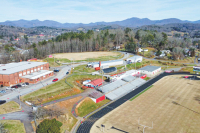The birth of a Haywood County institution: Negotiations for the Champion Fibre Mill and Peter G. Thomson’s Labor Day Legacy
By Patrick Willis • Guest Writer
Just more than 100 years ago, Canton welcomed a man from Ohio who would change the town’s history forever.
In early 1905, an industrialist named Peter G. Thomson decided to visit Western North Carolina with the hopes of building a pulp mill and extract plant to supply his paper factories in Ohio. Thomson knew vast timber in the Southern Appalachian Mountains would greatly benefit his business.
Born and raised in Cincinnati, Thomson worked his way up from a shipping clerk to running his own print and card shop before investing his earnings in a coated papermaking plant that began in 1894. The mill would eventually grow into one of the largest paper mill businesses in the United States.
Before Thomson came to Canton to build a mill, he first looked at other potential sites for his mill. Instead of looking out West like many other industrialists, Thomson looked to the Southeast to supply his Ohio operations.
Western North Carolina in the late 19th century was an area of loosely scattered, self-sufficient island communities focused primarily on subsistence agriculture and familial ties. As the region welcomed railroad lines and industrialization, the towns of Western North Carolina grew. However, the coming of industry did not mean that the older traditions of subsistence farming and barter exchange disappeared from mountain populations. Many families continued to farm while fathers and sons worked in the new mines or factories. Thomson’s idea for a new mill in Canton is a perfect illustration of the new industrialization of Western North Carolina and a dramatic shift to a new kind of lifestyle for many mountain residents.
Related Items
In February 1905, Thomson first met with J.Q. Barker of Andrews, who had met Thomson in Cincinnati and invited the industrialist to Western North Carolina to look for a suitable location for his new project. Leaders of Andrews and Murphy set up a conference to convince Thomson to build his mill in their respective towns. At the conference, Thomson and the leaders agreed that there was a larger quantity of timber in Cherokee, Clay, and Graham counties than in any other area of the same size in Western North Carolina. In addition, the quantity of pulp and acid woods in these three counties alone could run a mill and extract plant for 25 years.
However, when the question of a water supply came up, the leaders determined that Murphy had the preference over Andrews. Although the areas near Murphy and Andrews contained a great number of hemlock trees, there was no spruce timber in these counties. Unfortunately, Thomson wanted to be as close to the spruce lands as possible and told the town leaders he would give due consideration to their towns after looking at other possibilities.
After the conference with the town leaders of Murphy and Andrews, Thomson met with S. Montgomery Smith at Smokemont. Smith told Thomson about lands in Haywood County owned by the Haywood Lumber and Mining Company. The two toured the headwaters of the Pigeon River and the little town of Canton. These lands contained plenty of spruce timber and other hardwoods. Overall, three elements were required for Thomson’s new mill: sufficient land for the construction of the mill was necessary, about 40,000 acres of timber lands, and a way to ship materials from his new mill to the Cincinnati plant. Thomson felt that all of these needs were met in Canton.
One of the greatest advantages to the Canton site, Thomson thought, was the Pigeon River, which could be used to transport logs to the mill. Smith led Thomson to believe there was a sufficient drop in the Pigeon River from the headwaters down to Canton to build a flume that would supply the mill with cheap materials. However, later surveys showed that Smith’s survey reported a fall in the river of about half the actual fall, making it too flat to be used by the mill. Nevertheless, Thomson proceeded with his plans to build in Canton and used railroads to retrieve timber from the mountain forests to supply the mill.
Construction on the mill began in 1906 and took less than two years to complete. Despite its relatively quick completion, the construction process in Canton had its rough moments. Work in the fall and winter of 1906 and 1907 lagged behind due in part to exceptionally wet seasons. The mill’s location directly adjacent to the Pigeon River made the work site susceptible to flooding. When it would rain, the “bottom,” as the mill site was called, would turn into a sea of mud. Pipe trenches and foundation excavations would sink into the mud overnight and would have to be dug out again the following day.
The hard work was difficult for the workers, who were mostly local farmers who had very little experience on building a site this huge. Many of the workers wanted the extra income from the construction project, but most put a greater priority on their farms and families. When work had to be done on the farm, construction was forgotten and the worker headed home, returning only when the chores were complete.
As work lagged behind and became more expensive, the contractor decided to turn to a more reliant workforce. Head contractor Frank Gilbreth hired about 100 Bulgarians, who the locals insisted on calling “Rooshians” and who spoke very little English and lived on the mill site. As construction finished in late 1907, none of the foreigners who worked on the mill remained with the company as permanent employees.
In the beginning, the mill prospered and the number of employees and residents of Canton increased dramatically. When Thomson first set foot in Canton, the town contained about 350 residents. By the time the mill opened in 1908, there were close to 1,000 employees at the mill and many others working in and around town.
Businesses boomed with the influx of new people. Local inns and hotels created accommodations for new residents and visitors. The new working class and subsequent spinoff businesses in the early years of the 20th century led to the construction new boarding houses, inns, and neighborhoods throughout the town. Perhaps the most famous of the neighborhoods was Fibreville, a collection of 60 houses adjacent to the Pigeon River built by the company for employees.
In order to foster loyalty to the company, the mill gave employees discounted rental rates on these properties. If the tenant had rented from the mill after a certain number of years, the mill would deed the house to the employee. This example of benevolence from “Peter G.” (as Thomson was called) fostered a strong relationship between the mill and the town. Canton’s annual Labor Day celebration is a prime example of this connection. As a great proponent of the Labor Day holiday, Thomson knew the value of a loyal, hard worker.
George Smathers, Thomson’s attorney, revealed in his memoirs Thomson’s sense of loyalty to his workers at Champion. Smathers stated that if he had the amount of money Thomson had, he would “take life easy and live on it, and not be bothered with the trouble of building pulp mills and extract plants ....”
Thomson replied that “the man who had accumulated wealth had accumulated the same either directly or indirectly by the labor of other people and that he should use the same for the benefit of mankind.” Thomson “believed the construction of the pulp mill and extract plants at Canton would prove a great blessing to the people Haywood County and Western N.C. ... and give employment to people who were out of work and wanted to make an honest living.” Smathers added in his memoirs that “Mr. Thomson said that no man had greater respect and consideration for the honest laboring man than he had, and that he believed in paying the laborer the value of his services.”
Canton’s Labor Day tradition
Canton’s annual Labor Day celebration began in 1906. Labor Day was a relatively new holiday that began in the late 19th century as a day dedicated to the working man and woman. Samuel Gompers, a long-time leader of the American Federation of Labor, stated that “all other holidays are in a more or less degree connected with conflicts and battles of man’s prowess over man ... of glories achieved by one nation over another. Labor Day ... is devoted to no man, living or dead, to no sect, race, or nation.”
The first Labor Day holiday was celebrated on Tuesday, Sept. 5, 1882 in New York City as the Central Labor Union adopted a proposal and appointed a committee to plan a demonstration and a picnic. The Central Labor Union urged similar organizations in other cities to follow their example, and by 1885, many industrial centers were celebrating Labor Day. The day did not become an official holiday until 1894, when Congress passed an act making the first Monday in September a legal holiday.
Beginning in 1906, Canton, like other industrial cities and towns throughout the country, followed the prescribed pattern of a Labor Day celebration with a parade in which many of the workers working on the Champion mill and residents participated. Events included the Miss Labor Day Pageant (won in 1906 by Pearl Coleman Price), musical events, and fireworks. Canton’s Labor Day celebration grew to include athletic events, carnival rides, and speeches by prominent politicians and business leaders. Labor Day has been continuously celebrated for a century in Canton, and while some of the events have come and gone over the years, Canton’s Labor Day festivities still represent the devotion of a community and company to the American working spirit.









